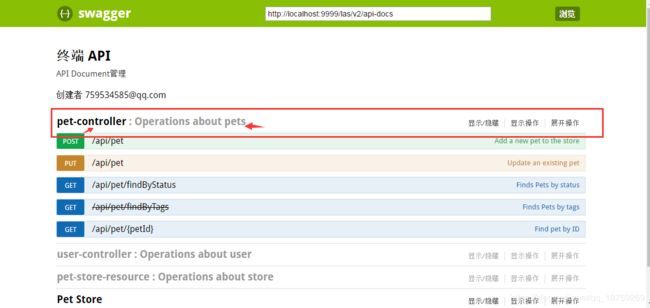Swagger 常用注解使用讲解
讲解内容
- swagger常用到的注解的解释
- SpringMVC中控制层类中使用这些注解
swagger常用到的注解的解释
在pom.xml文件中添加包依赖:swagger-annotations-1.5.10.jar
所有注解:
常用到的注解有:
- Api
- ApiModel
- ApiModelProperty
- ApiOperation
- ApiParam
- ApiResponse
- ApiResponses
- ResponseHeader
Api 标记一个Controller类做为swagger 文档资源
使用方式:
@Api(value = "/user", description = "Operations about user")
与Controller注解并列使用。 属性配置:
| 属性名称 | 备注 | 默认值 |
|---|---|---|
| value | url的路径值 | |
| tags | 如果设置这个值、value的值会被覆盖 | |
| description | 对api资源的描述 | |
| basePath | 基本路径可以不配置 | |
| position | 如果配置多个Api 想改变显示的顺序位置 | |
| produces | For example, "application/json, application/xml" | |
| consumes | For example, "application/json, application/xml" | |
| protocols | Possible values: http, https, ws, wss. | |
| authorizations | 高级特性认证时配置 | |
| hidden | 配置为true 将在文档中隐藏 |
在SpringMvc中的配置如下:
@Controller
@RequestMapping(value = "/api/pet", produces = {APPLICATION_JSON_VALUE, APPLICATION_XML_VALUE})
@Api(value = "/pet", description = "Operations about pets")
public class PetController {
}
定义后swagger效果图:
ApiOperation每一个url资源的定义
使用方式:
@ApiOperation(
value = "Find purchase order by ID",
notes = "For valid response try integer IDs with value <= 5 or > 10. Other values will generated exceptions",
response = Order,
tags = {"Pet Store"})
与Controller中的方法并列使用。
属性配置:
| 属性名称 | 备注 | 默认值 |
|---|---|---|
| value | url的路径值 | |
| tags | 如果设置这个值、value的值会被覆盖 | |
| notes | 对api资源的描述 | |
| response | 返回的对象 | |
| responseContainer | 这些对象是有效的 "List", "Set" or "Map".,其他无效 | |
| responseReference | 可以不配置 | |
| httpMethod | 可以接受 "GET", "HEAD", "POST", "PUT", "DELETE", "OPTIONS" and "PATCH" | |
| position | 如果配置多个Api 想改变显示的顺序位置 | |
| produces | 同 Api中的定义 | |
| consumes | 同 Api中的定义 | |
| protocols | 同 Api中的定义 | |
| authorizations | 同 Api中的定义 | |
| hidden | 同 Api中的定义 | |
| code | http的状态码 默认 200 | |
| extensions | 扩展属性 |
在SpringMvc中的配置如下:
@RequestMapping(value = "/order/{orderId}", method = GET)
@ApiOperation(
value = "Find purchase order by ID",
notes = "For valid response try integer IDs with value <= 5 or > 10. Other values will generated exceptions",
response = Order.class,
tags = { "Pet Store" })
public ResponseEntity getOrderById(@PathVariable("orderId") String orderId)
throws NotFoundException {
Order order = storeData.get(Long.valueOf(orderId));
if (null != order) {
return ok(order);
} else {
throw new NotFoundException(404, "Order not found");
}
}
ApiParam请求属性
使用方式:
public ResponseEntity createUser(@RequestBody @ApiParam(value = "Created user object", required = true) User user)
与Controller中的方法并列使用。
属性配置:
| 属性名称 | 备注 | 默认值 |
|---|---|---|
| name | 属性名称 | |
| value | 属性值 | |
| defaultValue | 默认属性值 | |
| allowableValues | 可以不配置 | |
| required | 是否属性必填 | |
| access | 不过多描述 | |
| allowMultiple | 默认为false | |
| hidden | 隐藏该属性 | |
| example | 举例子 | |
| examples |
在SpringMvc中的配置如下:
public ResponseEntity getOrderById(
@ApiParam(value = "ID of pet that needs to be fetched", allowableValues = "range[1,5]", required = true)
@PathVariable("orderId") String orderId)
ApiResponse响应配置
使用方式:
@ApiResponse(code = 400, message = "Invalid user supplied")
与Controller中的方法并列使用。 属性配置:
| 属性名称 | 备注 | 默认值 |
|---|---|---|
| code | http的状态码 | |
| message | 描述 | |
| response | 默认响应类 Void | |
| reference | 参考ApiOperation中配置 | |
| responseHeaders | 参考 ResponseHeader 属性配置说明 | |
| responseContainer | 参考ApiOperation中配置 |
在SpringMvc中的配置如下:
@RequestMapping(value = "/order", method = POST)
@ApiOperation(value = "Place an order for a pet", response = Order.class)
@ApiResponses({ @ApiResponse(code = 400, message = "Invalid Order") })
public ResponseEntity placeOrder(
@ApiParam(value = "order placed for purchasing the pet", required = true) Order order) {
storeData.add(order);
return ok("");
}
ApiResponses相应集配置
使用方式:
@ApiResponses({ @ApiResponse(code = 400, message = "Invalid Order") })
与Controller中的方法并列使用。 属性配置:
| 属性名称 | 备注 | 默认值 |
|---|---|---|
| value | 多个ApiResponse配置 |
在SpringMvc中的配置如下:
@RequestMapping(value = "/order", method = POST)
@ApiOperation(value = "Place an order for a pet", response = Order.class)
@ApiResponses({ @ApiResponse(code = 400, message = "Invalid Order") })
public ResponseEntity placeOrder(
@ApiParam(value = "order placed for purchasing the pet", required = true) Order order) {
storeData.add(order);
return ok("");
}
ResponseHeader相应配置
使用方式:
@ResponseHeader(name="head1",description="response head conf")
与Controller中的方法并列使用。 属性配置:
| 属性名称 | 备注 | 默认值 |
|---|---|---|
| name | 响应头名称 | |
| description | 头描述 | |
| response | 默认响应类 Void | |
| responseContainer | 参考ApiOperation中配置 |
在SpringMvc中的配置如下:
@ApiModel(description = "群组")
ApiModel相应配置
使用方式:
description="描述实体的作用" 属性配置:
| 属性名称 | 备注 | 默认值 |
|---|---|---|
| value | 默认为类的名称 | |
| description | 对该类的描述 | |
| parent | 可以不配置 | |
| discriminator | 可以不配置 | |
| subTypes | 可以不配置 | |
| reference | 引用配置可以不考虑 |
在SpringMvc中的配置如下:
@ApiModel(description = "群组")
public class UamGroup {}
ApiModelProperty相应配置
使用方式:
@ApiModelProperty(required = true, value = "群组的Id")
属性配置:
| 属性名称 | 备注 | 默认值 |
|---|---|---|
| value | 属性描述 | |
| name | 如果配置覆盖属性名称 | |
| allowableValues | 参考ApiParam配置项项 | |
| access | 可以不配置 | |
| notes | 没有使用 | |
| dataType | 数据类型 | |
| required | 参考ApiParam配置项项 | |
| position | 参考ApiOperation配置项 | |
| hidden | 参考ApiOperation配置项 | |
| example | 参考ApiParam配置项项 | |
| readOnly | ||
| reference | 参考ApiParam配置项项 |
在SpringMvc中的配置如下:
@ApiModelProperty(required = true, value = "群组的Id")
private String groupId;

